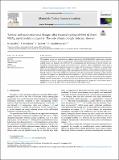Por favor, use este identificador para citar o enlazar a este item:
http://hdl.handle.net/10261/287739COMPARTIR / EXPORTAR:
 SHARE SHARE
 CORE
BASE CORE
BASE
|
|
| Visualizar otros formatos: MARC | Dublin Core | RDF | ORE | MODS | METS | DIDL | DATACITE | |

| Título: | Texture and microstructural changes after thermal cycling of 6061Al-20vol%SiCw metal matrix composite: The role of microscopic internal stresses |
Autor: | Eddahbi, M.; Fernández, Ricardo CSIC ORCID CVN; Llorente, Irene CSIC ORCID ; González-Doncel, Gaspar | Palabras clave: | Metal matrix composites Thermal cycling Texture Microstructure Microscopic internal stresses |
Fecha de publicación: | 2022 | Editor: | Elsevier | Citación: | Materials Today Communications 33: 104914 (2022) | Resumen: | The dramatic texture and microstructural changes observed in 6061Al-20vol%SiC metal matrix composite undergoing severe thermal cycles, under the absence and the simultaneous action of an external tensile stress, are studied. Under only thermal cycles (100–450 °C) homogenization and disorientation of the SiC whisker reinforcement and crystallographic texture randomization occurs. However, when a simultaneous tensile stress is applied, the whiskers rotate so that their long direction aligns with the tensile axes. Furthermore, a strong texture and large deformations (superplasticity), higher than 1000%, are achieved. These results are explained on the basis of the microscopic stress fields generated at the different microstructural scales (stresses of type II and type III) and well-known observation of dislocation generation at the SiC-metal interface during the cooling period of the cycles. We propose that moving dislocations (responsible of type III stresses) operate differently under the absence or the presence of the external stress. Under no stress, dislocation motion (occurring mainly during the heating period) is driven only by the type II internal stress. However, dislocation motion is improved when an external stress is applied, leading to texture changes and large elongations. Despite that a low external stress is applied, it overcomes the effect of the internal stresses for dislocation motion. | Versión del editor: | https://doi.org/10.1016/j.mtcomm.2022.104914 | URI: | http://hdl.handle.net/10261/287739 | DOI: | 10.1016/j.mtcomm.2022.104914 | Identificadores: | doi: 10.1016/j.mtcomm.2022.104914 issn: 2352-4928 |
| Aparece en las colecciones: | (CENIM) Artículos |
Ficheros en este ítem:
| Fichero | Descripción | Tamaño | Formato | |
|---|---|---|---|---|
| 1-s2.0-S235249282201755X-main.pdf | 5,24 MB | Adobe PDF |  Visualizar/Abrir |
CORE Recommender
Page view(s)
24
checked on 22-abr-2024
Download(s)
33
checked on 22-abr-2024
Google ScholarTM
Check
Altmetric
Altmetric
Este item está licenciado bajo una Licencia Creative Commons

